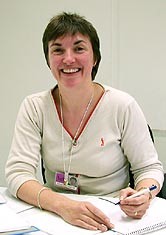Conservation Journal
Spring 2009 Issue 57
Editorial Comment - Conservation Journal 57

Sandra Smith
Every time conservators and scientists engage with an object or engage with the public, they have the potential to change thoughts and perceptions. From the complex (Melchar and Bamforth, Turnbull), to the grotesque (Sofer), from the eccentric (Rutherston) to the obscure (Marsh, Haldane et al) all our collections contain fascinating and enthralling stories. The Berkswell 'Cello (Egerton) is a classic example of how conservation can 'unlock' an object, creating links between the past and the present. Whilst the challenges of preserving theatre collections which were not designed to last longer than the performances in which they featured (Huxtable, Pendlebury) resonate with many of the issues that society faces today.
Through the continued improvement to display methods (Gatley), and practical treatment (Melchar and Bamforth), Conservation has helped to deliver 14 exhibitions, 24 displays, 10 FuturePlan projects (Oakley and Jordan), 9 Museum of Childhood events, as well as loans (Nodding and Oakley), and publications in 2008, many of which have received very positive reviews. Of the 6,000 or so objects conserved this year, some will have altered people's lives.
Most museums recognise the unique value of conservation and the potential for positive press as collections are prepared for galleries and displays, but conservators also need to recognise that their skills enable the institutions to meet more diverse government agendas; with 22 International and 21 UK touring exhibitions this year, safeguarding collections continues to be a focus of our research and development (Kelly). Venues now extend beyond Europe, America and Australia to the Near East and to the Indian Subcontinent. The concept of 'controlling the environment' takes on much larger connotations than simply that of light, temperature and humidity as events in Mumbai vividly highlighted to us in November whilst Indian Life and Landscapes (Wheeler) was being installed. The returns can be immense; In his Guardian article Simon Jenkins2 praised the V&A's World Ceramics: Masterpieces from the V&A exhibition as being the first star-quality loan exhibition ever seen in Syria, recognising that 'Here is Britain taking Syria and Syrians seriously and at face value', dealing with them 'culture to culture' whereby the importance and value of 'soft' cultural diplomacy is increasingly recognised.
Everyone in conservation and conservation science needs to engage with the issues raised by Demos and to recognise and find the opportunities to highlight the value of their work within the widest contexts. My thanks go to all the staff in the V&A Conservation Department for their professionalism and hard work, without their positive 'can do' approach the Museum could not have achieved such success this year.
References
1. Jones, S., Holden, J., It's a Material World: Caring for the public realm (Demos, 2008)
2. Jenkins, S. 'This show's diplomacy is for real - and it's worth a hundred Milibands', The Guardian, Friday 28 November 2008
http://www.guardian.co.uk/commentisfree/2008/ nov/28/comment-v-a-exhibition-syria-miliband (accessed December 2008)
Spring 2009 Issue 57
- Editorial Comment - Conservation Journal 57
- Investigation of a Victorian ornithological adornment
- From Cloister to Museum
- The Invisibles
- The conservation and technical examination of Bernadino Fungai's Virgin and Child with Two Saints
- Globe chair, adhesion and cohesion
- Book in a jar
- Transforming the Ceramics galleries: an exercise in restraint
- The Hampton Court terracotta roundels project
- What a Performance! The final curtain for the Theatre Museum
- Big boxes...who would make 'em? The housing of theatre set models
- Waking the Dead: scientific analysis of an Egyptian tunic
- Rocket science? A new method of poster display for Cold War Modern: Design 1945-1970
- Indian Life and Landscape - taking a travelling exhbition of paintings to India
- The Berkswell 'Cello? Past, present, future
- Making a statement: improving the condition reporting process
- Printer Friendly Version